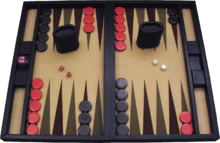Backgammon

A backgammon set, consisting of a board, two sets of 15 checkers, two pairs of dice, a doubling cube, and dice cups
|
|
| Years active | Approximately 5,000 years ago to present |
|---|---|
| Genre(s) |
Board game Race game Dice game |
| Players | 2 |
| Setup time | 10–30 seconds |
| Playing time | 5–60 minutes |
| Random chance | Medium (dice rolling) |
| Skill(s) required | Strategy, tactics, counting, probability |
Backgammon is one of the oldest board games known. It is a two player game where playing pieces are moved according to the roll of dice, and a player wins by removing all of their pieces from the board before their opponent. Backgammon is a member of the tables family, one of the oldest classes of board games in the world.
Backgammon involves a combination of strategy and luck (from rolling dice). While the dice may determine the outcome of a single game, the better player will accumulate the better record over series of many games, somewhat like poker. With each roll of the dice, players must choose from numerous options for moving their checkers and anticipate possible counter-moves by the opponent. The optional use of a doubling cube allows players to raise the stakes during the game.
Like chess, backgammon has been studied with great interest by computer scientists. Owing to this research, backgammon software has been developed that is capable of beating world-class human players (see TD-Gammon for an example).
Backgammon playing pieces are known variously as checkers, draughts, stones, men, counters, pawns, discs, pips, chips, or nips.
The objective is to remove (bear off) all of one's own checkers from the board before one's opponent can do the same. In the most often-played variants the checkers are scattered at first; as the game progresses they may be blocked or hit by the opponent. As the playing time for each individual game is short, it is often played in matches where victory is awarded to the first player to reach a certain number of points.
Each side of the board has a track of 12 long triangles, called points. The points form a continuous track in the shape of a horseshoe, and are numbered from 1 to 24. In the most commonly used setup, each player begins with fifteen checkers, two are placed on their 24-point, three on their 8-point, and five each on their 13-point and their 6-point. The two players move their checkers in opposing directions, from the 24-point towards the 1-point.
Points 1 through 6 are called the home board or inner board, and points 7 through 12 are called the outer board. The 7-point is referred to as the bar point, and the 13-point as the midpoint.
...
Wikipedia
